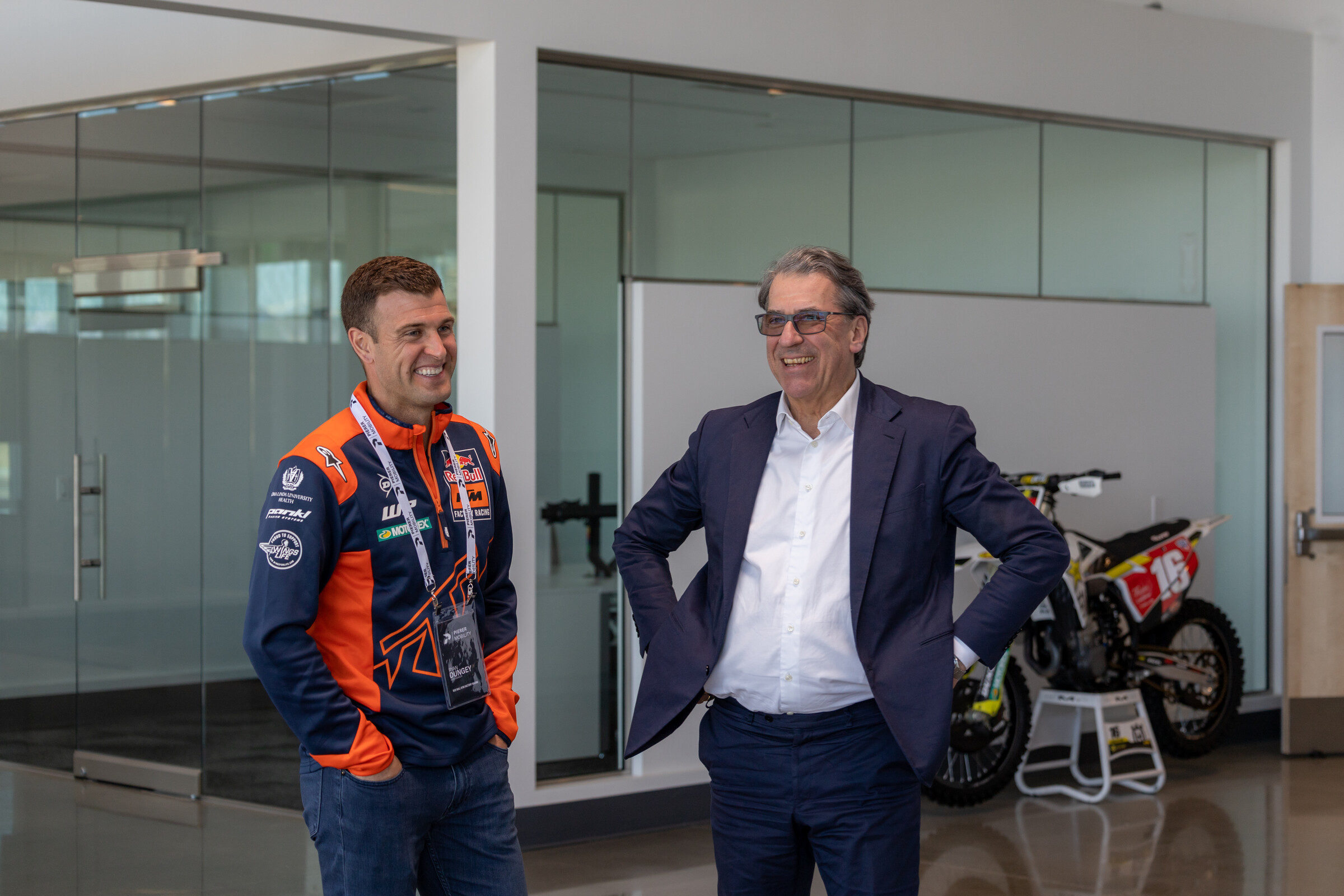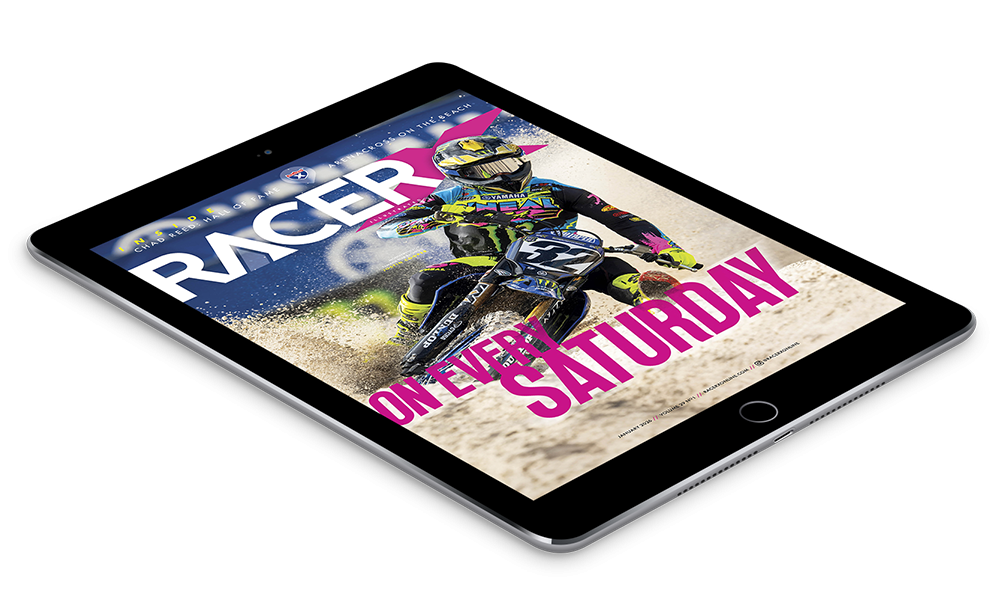Pierer Mobility is the name of the parent company for the KTM Group, named after Global CEO Stefan Pierer. Mr. Pierer took KTM out of bankruptcy in 1991 and planned to restore the company to profitability and flip it shortly after. Instead, he was convinced to stay. In the 30 years since, the KTM brand, and now other brands under the same structure, including Husqvarna and GasGas, have soared. MV Agusta motorcycles and Felt bicycles are the latest acquisitions for Pierer Mobility. Also, the company just launched its new $53 million-dollar North American campus in California. At the grand opening last week, we found 15 minutes to chat with Stefan Pierer.
Racer X: You said you took over the company basically 30 years ago. Were you a motorcycle person or was it just a good business opportunity at the time?
Stefan Pierer: At my young times, at that time, we didn’t have social media and those kinds of things, I grew up on the countryside so the power of a two-wheeler was basically the tool to join the group. Fifty cc’s through 80, being 13 or 14 years old, and then at 16 years old getting my motorcycle license. It's what the masses did at the time, ride motorcycles. But then you settle down and have a family, become a professional and then you stop. And then with the possibility in ’91 to take over KTM, there was one mentor I would say and it's a very famous KTM rider, Heinz Kinigadner (World Motocross Champion for KTM, also hailing from Austria). I knew him already since the late ‘80’s and he convinced me and said “Hey, it's an interesting case, look much closer.” So, I did and then I took it over. And after two years it went very well, I wanted to sell it because that’s where I came from, when I became an entrepreneur at that time startup was not famous, my startup idea was basically take companies that need to be restructured, they are usually very cheap. But then after we restructure it, sell it.
Heinz wanted you to stay?
Yeah, Heinz wanted me to stay. Because he restarted his career. He was going to Paris Dakar in ’94, so basically Heinz was the inventor of the success of the story of Dakar. He never finished at Dakar, but he brought in a new style of riding a rally, like a motocross guy. Very fast, he won stages but then he crashed.
But the way they approach it now is partially based on the style that he set by going faster and being more aggressive.
It’s a mentality issue, racing means you want to be on the podium, the top of the podium.
So, you ended up sticking with it much longer.
Yeah yeah, I was always listening to the racers and I got the message, “Don’t look back” because then you could over think it. Look ahead.
You mentioned today that racing is still why this brand is here. It’s still your foundation.
Racing first of all, technically wise, it forces innovation. First you decide a category, going to supercross or motocross, MotoGP. And then you see every weekend it's missing this thing. So you have to keep working. And then it is also creating an atmosphere for the whole team, all employees, they want to do everything to become closer (to the front).
But still, I would say a lot of times the CEO, they are looking at profit and loss, and things on a spreadsheet. And racing is so expensive that it is the first thing they want to NOT do.
Yeah, well that is the wrong approach. Because we know one simple thing: “Win on Sunday, sell on Monday.”
And you are sticking to that?
It's clear. And in off-road racing the product is very close to what the champion is riding. That is a little bit different than in street racing. Because in MotoGP, I would say it's 75% is marketing, brand reputation, and 25% is new technology heading towards the sold product.
But you know you must afford (spend) it. KTM is “Ready to Race.” That means we have to win.
MotoGP I am sure is a massive investment. But have you realized that “Look if we want to be the best we have to win at the most prestigious level?”
Yes. We are not…the Olympic theme is that it's nice to participate. We want to win. At least be on the podium. And that’s what’s driving us, and what’s driving me.
When you make these bold decisions, whether it’s “We are going to try to win supercross” which people didn’t think you would do and you did it. Or “We are going to try to win a MotoGP” which probably got the same reaction, does that give you or the company a little extra motivation?
Yeah, the whole company. And we are selling more. It pays off, we are growing. MotoGP is for sure a huge amount of money but finally the ratio of what we are spending in races is still the same as what we had 20 years ago.
The majority of the brands you have are high end brands. They are not necessarily entry level bikes to putt around on the farm. Is that something you have thought about going into?
If you assume you have a small quantity, you have to be the premium brand to justify the price tag. And then you must put in its design, its racing, its technology. That’s how it works.
That’s how your brands are going to do it. You don’t want to have bikes that sit twenty years unchanged, just roll them out every year.
Right, so every year you have to bring something up front. The lifecycle in off-road is three years.
So, now you’ve spent $53 million on a new building. This is not the vision you had 28 years ago when you are like “Two years is up, it's time to sell!” I assume you were not thinking you would be at these heights.
No, no, no. This new building? Like I said, I feel like I’m in a movie.
It's not even real to you yet?
[Laughs] I feel like an actor in a reality movie!
But look, 53 million dollars is big. Does it keep you up at night making that big of an investment or do you have that much confidence?
No, because after 30 years of success you are sure it will pay off.
Does having the racing blood within every part of the company help that? That’s how racers think, right? “Whatever I have to do to get to the next level I am willing to do it. I have to bet on myself.” Is that kind of a racing mentality that the company has?
First of all just do it. Instead of making all of the power point presentations. Just do it. Then you know if it works, proceed, and if it doesn’t, turn around and make it right. And that is the success of an entrepreneur is trial and error. Don’t repeat any mistakes and you must be lucky to survive they mistakes. So it is as simple as that, if it works than you are successful.
But also, I am sure you are never resting on your laurels, it would be easy for you to say “Look how far we’ve come, we are doing great.”
No, no, no. That is where we learn from the races: “Don’t look back, look ahead.”
Where you have been making a lot of strides is with bicycles, that’s the new thing. Are you getting to the point where those two segments, they are going to become almost the same? Powered bicycles and motorcycles. Are they becoming more and more similar?
Yeah, on the electric powertrain for sure, but a real pure bicycle is different. It's a different approach, although most of our customers do use it for training. But the electric powertrain it is coming closer to a powered two-wheeler. You have warranty, you have a lot of service, and that’s the reason we decided to step in.
Because you have that expertise already?
We have the expertise, but we are still beginners and learning. Because it's a tough market, and the big players are there. And compared to the motorcycle industry, the whole component industry went to the far east, to China and Vietnam. And we have a very long supply chain. A long lead time, so you must have deep pockets. There is only one US component manufacturer we use that I like, it’s SRAM. It’s becoming a real competitor against Shimano.
So the motorcycles are built in Austria.
In Austria or India or in China.
But you are saying the bicycles are much more complex than that?
For the motorcycles I control basically the whole supply chain. Within five, six months I can react if something goes up or down. But for the bicycles it's one and half years later. Which is crazy.
Not for development, but for actual production?
Yeah yeah, ordering the parts, and it's one and half years and we must define precisely the quantities and specifications and hopefully one and half years later you are getting it right in time. Secondly you are building a product that hopefully the dealer is actually selling. In my opinion it [the bicycle business] is an outdated business structure, and now we are doing a restructuring. We are bringing back a lot of things to Europe, we have set up a corporation in Bulgaria. And you must do some components in the USA. For suspension we know how it works, for sure we are going into suspension. That is not confidential. I want to get closer with SRAM so that we can get rid of the Asian suppliers.
So you are learning. With the bicycle side there’s a long ways to go here.
It's a learning curve. But we want to become a global player, that means one billion sales globally.
For bicycles? One billion?
Just for bicycles. One billion in sales.
Wow. And is every bicycle you have powered?
I would say we’re 90% E-bike. We have taken over Felt (which also sells non-powered bicycles), and I think we have a very prestigious brand, and we have a nice bicycle program. And with Husqvarna and GasGas we are just doing E-bikes. Because you can add on to any motorcycle dealer network immediately over at GasGas or Husqvarna. The dealer doesn’t have anything to invest, you just put it in. And that’s the reason that they like it, and they were pushing, saying “Hey, the others [bicycle brands] are coming into these dealerships, too, Specialized and others.” So we say, okay, we close the door and we do it ourselves.
Do you think there will be a time in the future where we are like “I am not sure if that is an E-bicycle or an electric motorcycle?” There will always be distinct ones, but I almost feel like we are going to see something in the middle, that’s a little of both.
Why does it work on an E-bicycle? Because you have a very small battery maybe 700-800 watt hours. So, you have the space to put it, although the frame looks a little bit big. And you have a hybrid, even if the battery is running out you still pedal. And that’s the reason we decided to step in [to electric motorcycles] for kids bikes and for young customers. So, we are selling thousands of them because we have a small battery, and the mileage is not the most important. The biggest challenge for bigger motors [full size motorcycles] is you don’t have the space. The energy density of one liter of gasoline compared to the battery means you have ten times the size and weight. How does it work for a 10-liter tank? What are you doing with a 100 kilo [220 pound] battery? Where are you putting that? But for a kids bike it's [a small battery] enough.
So there are significant technical challenges to make a full-size motorcycle that you could ride for an hour.
It's more or less a space issue, it's not a technical thing. If you are looking at an adventure bike with a 20-liter tank, it's not possible. With the current battery technology, it's not possible. You can go up to 125cc that means 11 kilowatts, that works. And on a scooter that works as well because you have to space for helmets, that you can fill up with batteries. But on an off-road bike where do you put it? You want to win, and to do that you have to race 25 or 30 minutes plus two laps. I doesn’t work. It's very simple.
So until battery technology has a massive breakthrough you can only do so much.
Only to 125. And you can use it with low voltage, 48 Watt. That means there’s no restrictions for delivery and warehousing [the product]. If there is more [voltage] than that, then it's high voltage and you have to tell the dealer you have some restrictions on protection because it's dangerous.
And does that effect charging time if you have high voltage?
For sure it's [charging time with high voltage] quicker, but with all of the disadvantages [on shipping and other restrictions with that voltage]. We are the pioneer in electric mobility, we started in 2013 with our Freeride electric bike, with a high voltage concept. Maybe you have read from Ford they have announced now they are losing money on the electric cars. We did the same. It took ten years. With the small batteries [like mini motorcycles and e-bicycles] we manage, but with the big bikes it's not [there]. And then the dealer has to have a special warehousing system that costs them a lot of money. Secondly the logistics [of battery power] are very, very difficult. And even on the production you have to have some restrictions.
So the 450 style bike is not ready?
Technically it's nice but you don’t have the duration for a race. And if you have investors with stupid money, okay, someone is covering your loss. But I am an entrepreneur, I want to earn money. Every month I have to pay salaries and wages.
So can’t sink that money into batteries?
No, and why should I send it to China or wherever? It's common sense.
The battery is just not there yet. No matter what else you engineer around that battery.
If you have a car where you have space on the bottom to add on 100 kilo of battery it works. But somebody has to pay the bill! So for me I would say that electric mobility is for short distances. Urban mobility is perfect, and if you are going longer distances [with electric], that is more or less for wealthy and rich people. So that’s it. Just keep it like it is.






